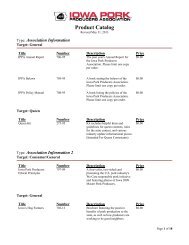Pork Congress 2012 - Iowa Pork Producers Association
Pork Congress 2012 - Iowa Pork Producers Association
Pork Congress 2012 - Iowa Pork Producers Association
Create successful ePaper yourself
Turn your PDF publications into a flip-book with our unique Google optimized e-Paper software.
System to save energy, reduce ammonia<br />
emissions from livestock facilities developed<br />
Researchers from North<br />
Carolina State University and<br />
West Virginia University have<br />
developed a new technology<br />
that can reduce air pollutant<br />
emissions from some chicken<br />
and swine barns, and also<br />
reduce their energy use by<br />
recovering and possibly<br />
generating heat.<br />
Specifically, the research team<br />
designed, built and evaluated<br />
a proof-of-concept unit that<br />
incorporates a biofilter and<br />
a heat exchanger to reduce<br />
ammonia emissions from<br />
livestock barns, while also<br />
tempering – or heating up – the<br />
fresh air that is pumped into the<br />
barns.<br />
The pollution removal component<br />
utilizes a biofiltration mechanism,<br />
in which polluted air is passed<br />
through an organic medium, such<br />
as compost or wood chips, that<br />
contains bacteria. Those bacteria<br />
interact with the pollutants and<br />
break them down into harmless<br />
or less harmful constituents.<br />
Biofiltration also allows recycling of<br />
nitrogen because when the “spent”<br />
medium is applied on cropland, the<br />
nitrogen becomes available to the<br />
crops. However, biofiltration also<br />
introduces additional costs for<br />
animal agriculture operations. The<br />
researchers hope to defray those<br />
costs by reducing an operation’s<br />
energy consumption.<br />
Here’s how their prototype works:<br />
warm, polluted air from the<br />
livestock facility enters the biofilter,<br />
and some of the heat is transferred<br />
to the heat exchanger. When fresh<br />
air from outside is pumped into<br />
the building, it passes over the heat<br />
exchanger, warming it up.<br />
The prototype not only helps<br />
recover heat from the facility, it also<br />
produces its own heat. This heat<br />
12 March <strong>2012</strong>













